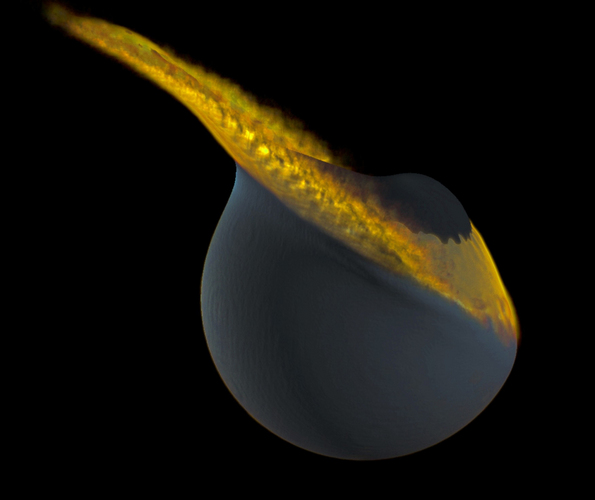Science News
Another Earthly Moon?
August 4, 2011

Jupiter has at least 64. Saturn, 62 or more. Heck, even Pluto, which really isn’t a true planet, has four known moons. And Earth? Just one.
But it’s quality, not quantity right? Our Moon is spectacular and well-studied, yet still a mystery. Take the differences of each side of the moon.
The near side is relatively low and flat, while the topography of the far side is high and mountainous, with a much thicker crust. “The fact that the near side of the moon looks so different to the far side has been a puzzle since the dawn of the space age, perhaps second only to the origin of the moon itself,” says Francis Nimmo, a professor of Earth and planetary sciences at UC Santa Cruz.
Last year, Nimmo and another UC Santa Cruz researcher published a theory for these differences; they suggested that tidal forces were responsible for shaping the thickness of the moon's crust.
This week, two other UC Santa Cruz colleagues published a very different theory in the journal Nature. Their study builds on the "giant impact" model for the origin of the moon, in which a Mars-sized object collided with Earth early in the history of the solar system and ejected debris that coalesced to form the moon. The study suggests that this giant impact also created another, smaller body, initially sharing an orbit with the moon, that eventually fell back onto the moon and coated one side with an extra layer of solid crust tens of kilometers thick.
That means that at one point, Earth possibly had two moons. New Scientist cries cannibalism!
Family squabbles rarely result in cannibalism, but that may be just what happened in the moon's youth. It may have gobbled up a smaller sibling, making itself permanently lopsided.
In the new study, Erik Asphaug and Martin Jutzi used computer simulations of an impact between the moon and a smaller companion (about one-thirtieth the mass of the moon) to study the dynamics of the collision and track the evolution and distribution of lunar material in its aftermath. In such a low-velocity collision, the impact does not form a crater and does not cause much melting. Instead, most of the colliding material is piled onto the impacted hemisphere as a thick new layer of solid crust, forming a mountainous region comparable in extent to the lunar farside highlands.
“Of course, impact modelers try to explain everything with collisions. In this case, it requires an odd collision: being slow, it does not form a crater, but splats material onto one side,” Asphaug said. “It is something new to think about.”
ScienceNOW explains how this new study of a slow collision does build upon previous work:
… the slowest-moving impacter would be one in the same orbit as the moon. Earlier work by others had shown that smaller, secondary bodies would also coalesce from the debris of the collision with Earth that created the moon. Studies had also shown that only a secondary moon orbiting Earth at a gravitational balance point just ahead of or behind the moon would survive more than a few million years before slowly colliding with the moon.
Asphaug agrees. “Our model works well with models of the moon-forming giant impact, which predict there should be massive debris left in orbit about the Earth, besides the moon itself. It agrees with what is known about the dynamical stability of such a system, the timing of the cooling of the moon, and the ages of lunar rocks.”
And while Nimmo may disagree on the specifics, he values his colleagues’ work. “One of the elegant aspects of Erik's article is that it links these two puzzles together: perhaps the giant collision that formed the moon also spalled off some smaller bodies, one of which later fell back to the moon to cause the dichotomy that we see today.”
For now, he said, there is not enough data to say which of the alternative models offers the best explanation for the lunar dichotomy. “As further spacecraft data (and, hopefully, lunar samples) are obtained, which of these two hypotheses is more nearly correct will become clear.”
Image: Martin Jutzi and Erik Asphaug/Nature